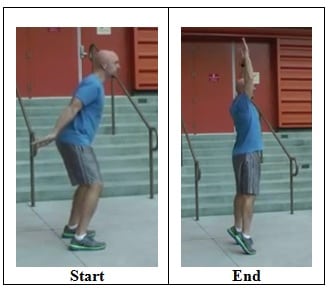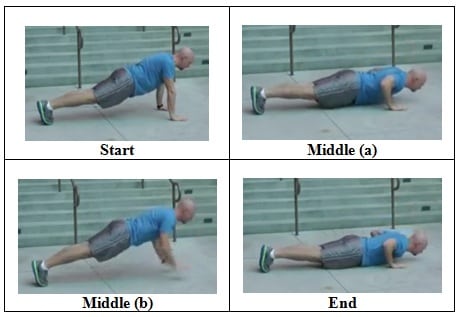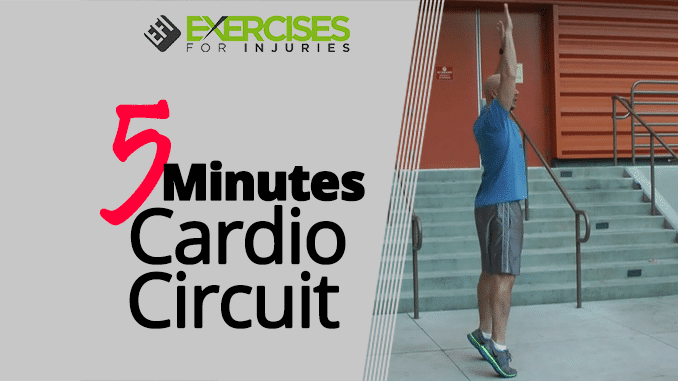Disclosure: This 5-Minute Cardio Circuit is meant to help you stay active and healthy, but it might not be right for everyone. If you have any injuries, medical conditions, or concerns, it’s always a good idea to check with your doctor before starting. Make sure to follow the exercises at your own pace, use proper form, and listen to your body. Everyone’s results will be different, and what works for one person might not work the same for another.
Hey, it’s Mike Whitfield here with Workout Finishers. I have a special treat for my friends over at Exercises For Injuries. I want to talk about doing a 5-Minute Cardio Circuit that’s easy to fit into your daily fitness routine.
We are doing only a 5-minute cardio circuit because this is important, and I truly believe it is something we need to do every day. I like to work out three days a week, sometimes 4, which allows me to stay active on the other days. That is having more time to play with my kids and play basketball.
I love to play basketball, and sometimes I go for a swim because of the positive impact this has on my mental state. It helps me make better decisions with food and puts me in the right mindset. Another reason is that it promotes a natural boost of energy. You don’t have to rely on stimulants or coffee.
When you do a short bodyweight circuit, it can provide you with a nice surge of energy. You can do this on an off day, requiring no equipment.
It’s a 5 minutes cardio circuit, so that means we will be doing a lot of legs, but we will also add in some pushing movements.

As Peloton instructor Andy Speer explains, “Circuits are a magical combination of muscular and cardiovascular exercise that can be programmed for a variety of goals and fitness levels, from beginner to advanced.”
Speer advises organizing cardio exercises to target different muscle groups consecutively, which “increases metabolic demand and decreases fatigue in any single muscle group.”
For beginners, Andy recommends starting with a 1:1 work-to-rest ratio, such as 30 seconds of exercise followed by 30 seconds of rest, and gradually reducing rest periods over time. He also suggests incorporating familiar movements into circuits to focus on performance rather than learning new exercises, enhancing both physical and mental engagement.
Key Benefits of the 5-Minute Cardio Workout

This short workout gets your heart pumping [1] and strengthens your muscles. It’s an example of circuit training, which combines strength and aerobic exercise.
- Boosts energy naturally—no need for caffeine.
- Strengthens muscles in your legs and upper body.
- Helps prevent injuries by using safe, controlled movements.
- Fits into any schedule—it’s just 5 minutes!
What if I told you that in just 12 weeks, you could feel like a brand-new person?
That’s what happened to Phil, at 65 participated Burn the Fat Challenge program focused on strength, cardio workouts, and maintaining a healthy diet. The results? Lost 18 pounds, improved his muscle mass, and experienced tons of energy.
Asher Freeman, C.P.T., explains that cardio strengthens the heart and lungs, supports strength training, and improves daily activities. They recommend low-impact exercises like biking, swimming, and bodyweight moves, which protect the joints while raising heart rate.
Freeman suggests doing more reps, taking shorter breaks, or moving longer to increase intensity, and focusing on exercises that work several big muscles. They emphasize varying workouts to prevent joint strain and offer an adjustable AMRAP (as many rounds as possible) workout plan.
Cardio Circuit Exercise
1. Lunge Jump

- Begin in an upright standing position with your feet staggered, one foot forward and one back, with arms at your sides and knees slightly bent, maintaining good alignment with your head shoulders and hips.
- Lower into a lunge position, ensuring your back knee is just a few inches above the ground and your front thigh is parallel to the ground.
- Engage your core and explosively jump up, switching the position of your legs mid-air, using your arms to help propel you.
- Land softly back into a lunge with the opposite leg forward, keeping your core engaged.
- Repeat the movement.
- Complete 5 repetitions.
Now, if your knees are not ready for something like that, do a Total Body Extension instead. So, we will do 10 full-body extensions instead of 5 per side with the lunge jumps.
Variation Exercise: Total Body Extension

- Begin in an upright standing position with your feet shoulder-width apart and your knees slightly bent, maintaining good alignment with your head, shoulders, and hips.
- Engage your core.
- Push your hips back and swing your arms behind you, keeping your back straight.
- Explosively extend your hips, knees, and ankles as you return to standing, swinging your arms overhead and rising onto your toes.
- Quickly lower your heels and transition smoothly back into the starting position.
- Repeat the movement.
- Complete 10 repetitions.
Again, we are going to crank our heart rate up. You can do regular push-ups if you are not ready for explosive push-ups.
2. Explosive Push Up

- Begin in a push-up position with your hands shoulder-width apart and your body forming a straight line from head to heels.
- Lower your chest toward the ground by bending your elbows, then explosively push through your hands to propel your upper body off the ground, keeping them close to your body.
- Push off the ground with maximum force, lifting your hands off the floor so your body rises slightly.
- Land softly back in the starting position and immediately transition into the next repetition.
- Complete 5 repetitions.
Keep your core engaged, avoid arching your back, and ensure controlled landings to prevent injury. Beginners can modify by starting on their knees, while advanced variations include clapping or adding lower-body movements for more intensity.
Again, if you are not ready for those, by all means, do regular push-ups. You are going to do 5 of those as well.
Modification: If explosive push-ups feel hard, do regular push-ups instead. These also build upper body strength.
3. Skater Hops

- Begin in an upright standing position with your feet shoulder-width apart and your arms at your sides, maintaining good alignment with your head, shoulders and hips.
- Engage your core.
- Shift your weight onto your right foot and lift your left foot off the ground, bending your knee.
- Use your arms for balance, swinging them naturally.
- Jump to the right, landing on your left foot and immediately shift your weight onto your left foot and lift your right foot off the ground, bending your knee.
- Repeat the sequence of movement, starting with 1 set of 5 – 10 repetitions.
Begin with small, slow hops to master balance and form, then increase speed or jump distance for added intensity. Skater hops can be done for reps or timed intervals as part of your workout.
4. Jumping Jacks

We are going to end the routine with 5 Jumping Jacks. This is a great conditioning exercise and great for shoulder mobility as well. For variations, try low-impact steps, increase speed, or hold small weights for more intensity. This versatile move fits well in warm-ups, cardio, or circuit routines.
This classic cardio exercise is great for raising your heart rate. Now I am out of breath just demoing it, so you can imagine what the 5-minute cardio circuit will do. It’s a great way to stay active and get a nice surge of energy without stimulants and caffeine.
Why It Works
This quick circuit:
- Improves cardiovascular health [2] and energy levels.
- Incorporates functional movements for injury prevention.
- Can be customized for beginners or advanced athletes with modifications.
Darci Revier, Director of Education for the National Exercise Trainers Association, also shares her perspective. She highlights the time-saving aspect of circuit training: “This saves time because it allows for active recovery. Instead of rest breaks, you just work a different part of the body.
Revier emphasizes the suitability of circuits for those without access to heavy equipment: “Circuits are ideal for people without access to heavy equipment or those who like to work out at home.”
Safety First: Injury Prevention

This circuit is designed with injury prevention in mind. Below are specific tips and examples to ensure you stay safe while performing the exercises:
- Warm-Up (3-5 minutes) – Before you start, warm up your body to avoid injury. Try marching in place or gentle arm swings. Make sure to move your legs and keep your feet hip-width apart for balance.
- Maintain Proper Form for Joint Safety – Keep knees aligned during Lunge Jumps or opt for Total Body Extensions to protect joints. Letting your knees collapse inward during Skater Hops may lead to ligament injuries.
- Engage Your Core to Protect Your Spine – Prevent back strain during explosive push-ups by keeping your core tight. If you’re recovering from a lower back injury, start with a modified push-up on your knees.
- Control Impact Levels – Replace high-impact moves like jumps with gentle alternatives. For example, switch jumping jacks with side steps if recovering from joint issues.
- Cool Down to Avoid Stiffness – After completing the circuit, stretch the quads, hamstrings, and shoulders to reduce stiffness.
Personalized Recovery Plan

If you’re unsure how to start or need guidance for your specific situation, you can create your own Personalized Recovery Plan right now. It’s easy and doesn’t require any fancy tools—just follow these simple steps:
1. Assess Your Fitness Level
Ask yourself:
- Are you currently active, or are you just starting out?
- Do you have any injuries or areas of discomfort (e.g., knees, back, shoulders)?
If you’re dealing with injuries, choose low-impact modifications, like total body extensions instead of lunge jumps, and step-outs instead of jumping jacks.
2. Set Your Goals
What do you want to achieve with this circuit?
- Recover from an injury: Focus on gentle, controlled movements and prioritize proper form.
- Build strength: Stick to the standard versions of each exercise and gradually increase intensity.
- Boost energy and endurance [3]: Perform the exercises back-to-back at a steady pace.
3. Choose Your Routine
Here’s how to customize the circuit to your needs:
- Beginner: Perform each move slowly with breaks in between. Start with modifications (e.g., step-outs for Jumping Jacks) and do 1–2 rounds.
- Intermediate: Perform each move at a moderate pace, aiming for 2–3 rounds with minimal rest.
- Advanced: Perform each move as quickly and explosively as possible while maintaining proper form. Complete 3–5 rounds.
4. Track Your Progress
Keep a simple journal or note on your phone. Write down:
- How many rounds you completed.
- How you felt during and after the workout (e.g., energized, sore).
- Any adjustments you made for comfort or recovery.
Example:
- Day 1: Completed 2 rounds, modified Explosive Push-Ups to regular push-ups, felt good.
- Day 7: Completed 3 rounds with full Explosive Push-Ups, feeling stronger!
5. Add Rest Days and Recovery
To avoid overtraining or aggravating injuries:
- Do the circuit 3–4 times a week, with rest days in between.
- On rest days, focus on light activities like walking or stretching.
Do the circuit 3–4 times a week, with rest days in between.
Example Recovery Plan:
Here’s a sample plan for someone recovering from a knee injury:
- Day 1: 2 rounds of the circuit, using Total Body Extensions and side steps instead of jumping.
- Day 2: Rest or gentle stretching.
- Day 3: 3 rounds with slow Skater Hops for lateral strength.
- Day 4: Rest day.
- Day 5: 3 rounds with steady, controlled movements.
Shawn Arent, PhD, Chair of the Department of Exercise Science at the University of South Carolina, notes that while circuits are effective for general fitness, they may not be optimal for specific goals: “They won’t build as much overall strength as traditional strength training, and they won’t build up your cardiovascular system as efficiently as normal cardio work. But they’re pretty good at building a little bit of both.”
Your Next Steps
Here’s how to start:
- Use the Personalized Recovery Plan Tool to customize your workout.
- Schedule 5 minutes in your day for this circuit.
- Follow the safety tips and choose modifications as needed.
With consistency, this circuit can help you stay active, injury-free, and full of energy.
Conclusion
In just 5 minutes, I can turn things around—boost my energy, feel stronger, and get moving without worrying about injuries or needing any special gear.
What I love about this cardio circuit is how easy it is to fit into my day. Whether I’m taking it slow or going all in, it works for me.
It’s not just about exercise; it’s about feeling good, staying balanced, and keeping my body strong. And honestly, if just five minutes can make such a big difference, why not go for it?
Thanks for joining me, and a big shoutout to Rick and Exercises For Injuries for hosting this! Together, let’s move forward—stronger, healthier, and happier.
~ Mike Whitfield ~
Pump up your health in just 7 minutes a day with a program that’s gentle, simple, and really effective— perfect for those who need cardio for those who hate cardio. Imagine a workout that doesn’t leave you feeling tired and sore but still gives you amazing results. Check out now this Cardio For Those Who Hate Cardio.
Frequently Asked Questions
How long should a cardio circuit be?
A cardio circuit can range from 5 to 30 minutes, depending on your fitness level and goals. Even a quick 5-minute circuit, like this one, can give you a great energy boost and help maintain consistency in your routine.
Are cardio circuits good?
Yes! Cardio circuits are a fantastic way to combine strength and cardio, improve endurance, burn calories, and boost energy in a short amount of time. Plus, they’re adaptable for all fitness levels.
How to do a cardio circuit?
Pick 3–5 exercises that target different muscle groups, like jumping jacks, push-ups, and skater hops. Perform each exercise for a set time or number of reps, one after the other, with little to no rest in between. Repeat the circuit as many times as you’d like.
What is a cardiovascular circuit?
A cardiovascular circuit is a workout that combines heart-pumping movements with strength or functional exercises. The goal is to keep your heart rate up while challenging multiple muscle groups for a full-body workout.
What is a good cardio schedule?
Aim for at least 3–4 cardio sessions per week, alternating with strength or flexibility-focused workouts. For circuits, you can do them 2–3 times a week or even daily if they’re short and low-impact, like this 5-minute routine. Always listen to your body and include rest days when needed.


